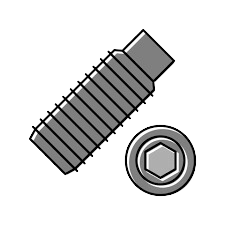Overview of Set Screws and Grub Screws
Set screws are a fundamental component in mechanical engineering and various industrial applications. These screws are typically used to secure an object within or against another object, without the use of a nut. They achieve this by threading into a threaded hole in one part and exerting pressure on another part by means of the screw tip. This mechanism is particularly useful in preventing relative motion between the parts, ensuring a stable and secure assembly.
Grub screws, a subset of set screws, are distinguished by their lack of a head. These headless screws are fully threaded and are often used in applications where the screw needs to sit flush with or below the surface of the material, offering a clean and unobtrusive finish. Commonly, grub screws are employed in securing pulleys, gears, and other components to shafts, where space constraints or aesthetic considerations demand a headless fastener.
Set screws come in a variety of types, each designed for specific applications and conditions. For instance, cup point set screws feature a concave tip that provides superior holding power, making them ideal for softer materials. Cone point set screws, with their sharp, pointed tips, are suited for applications requiring precise alignment. Flat point set screws are preferred in scenarios where minimal surface marring is desired.
The materials used for set screws range from stainless steel to alloy steel, each offering different levels of strength, corrosion resistance, and durability. Additionally, set screws come in various sizes and thread types, ensuring compatibility with a wide array of applications and mechanical systems.
While set screws offer several advantages, such as ease of installation and adjustability, they also have certain limitations. They may not be suitable for high-torque applications, as the pressure exerted by the screw tip can lead to deformation or damage over time. Furthermore, the reliance on friction to secure components may not be sufficient in dynamic or high-vibration environments.
Understanding the specific characteristics and appropriate uses of set screws and grub screws is crucial for optimizing their performance in mechanical and industrial contexts. Proper selection and application can lead to more reliable and efficient assemblies, minimizing the risk of failure and maximizing operational longevity.
Specialized Types: Nylon Tip and Brass Tip Set Screws
Nylon tip and brass tip set screws represent specialized variants designed to cater to unique application requirements where standard set screws might fall short. These specialized set screws offer distinct advantages in terms of material properties and functionality, making them indispensable in certain scenarios.
Nylon Tip Set Screws
Nylon tip set screws are characterized by their non-marring contact points, which are particularly valuable in applications where damage to the mating surface must be minimized. The nylon tip provides a cushioning effect, ensuring that the surface remains unmarred even under significant pressure. This makes them ideal for use in precision instruments, optical devices, and any assembly where surface integrity is paramount.
In addition to their non-marring properties, nylon tip set screws excel in vibration resistance. The nylon material acts as a buffer, dampening vibrations that could otherwise loosen traditional metal set screws. This feature is especially beneficial in automotive and aerospace applications, where maintaining screw stability under dynamic conditions is crucial.
Brass Tip Set Screws
Brass tip set screws offer a softer, non-corrosive contact point, making them suitable for applications where electrical conductivity and resistance to oxidation are essential. The brass tip ensures a stable electrical connection, which is why these screws are frequently employed in electrical assemblies and delicate mechanical systems. Additionally, brass is less likely to cause galvanic corrosion when in contact with other metals, enhancing the longevity of the components involved.
Comparative Analysis
When deciding between nylon tip and brass tip set screws, it is important to consider the specific requirements of your application. Nylon tip set screws are superior when non-marring and vibration resistance are the primary concerns. Conversely, brass tip set screws are the preferred choice in scenarios demanding non-corrosive, electrically conductive contact points.
In summary, both nylon tip and brass tip set screws offer unique benefits tailored to specialized applications. By understanding the distinct advantages and limitations of each type, you can make an informed decision that ensures optimal performance and longevity of your assemblies.
